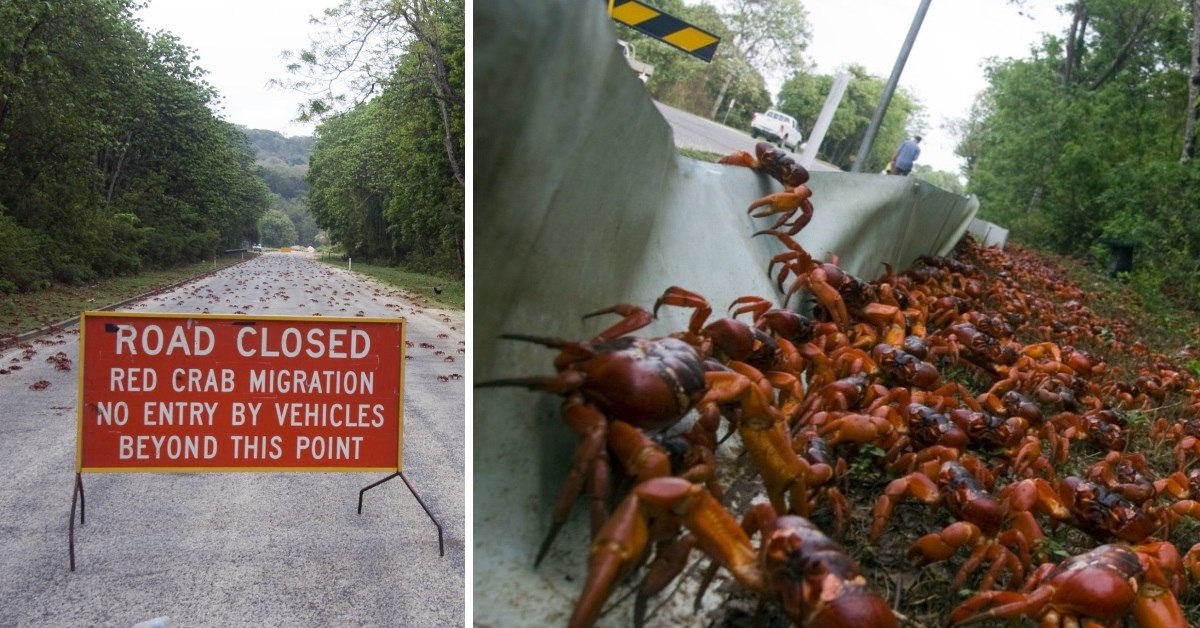Millions of red crabs move from the forests of Christmas Island to the shore of the ocean every year.
Christmas Island, a small island in the Indian Ocean, belongs to Australia. The red crabs that live there and are unique to that area are its most famous species. According to the Australian government, the island is home to roughly 50 million red crabs. At the first rain of the wet season, millions of red crabs come out of the forest., traveling across cities, roads, and bridges on their way to the Indian Ocean to breed.
The main tourist attraction on Christmas Island is this occasion, which attracts visitors who enjoy the outdoors from all over the world.
These large crabs have a maximum width of around 4.6 inches (116 millimeters), however males typically grow larger than females. Most of the time, their razor-sharp claws are around the same size. Like many other crab species, even if these limbs are damaged or lose their limbs, they can regenerate new ones. The majority of them are vivid red, but some are occasionally orange or, much less frequently, purple.
Red crabs spend the most of the year in holes they have dug or in hidden deep rock crevices. They also cover the entrance to their burrows with leaves during the dry season to maintain the humidity inside since they require a lot of moisture. As a result, they disappear entirely for months.
Red crabs emerge from their burrows between October and December, just before the rainy season is ready to resume, and travel to the Indian Ocean shore, where they mate and lay their eggs. The vibrant lines of crabs, which are made up of both male and female crabs, are led by male crabs. The crab masses can take up to a week to reach their target, and during that period, they can appear everywhere. They typically travel a great distance on their journey. Crabs may securely cross roadways thanks to the bridges and underpasses installed by authorities and park employees.
Crabs always depend on a specific moon phase to determine the precise time of their egg-laying. They consistently deposit their eggs during the final quarter of the moon, just before the morning tide recedes. Amazingly, these little animals are able to predict when it is optimum to emerge from their burrows and give birth.

Crabs enter the water to obtain more water as soon as they reach the beach. The males proceed to the lower terraces of the shore to dig burrows after taking a relaxing bath. However, there are many of these burrows since there are so many crabs, and male crabs frequently fight over who gets to live in them. Then, on the terraces, the female crabs encounter the male crabs, and they mate underground. The males take another ocean swim after mating, then they begin to migrate back to the area where they spend the most of the year.
The female crabs stay in the fresh tunnels they excavated after mating and lay their eggs in three days. They may each lay up to 100,000 eggs at once, and they remain with the eggs for two weeks as they develop. Crabs carry their eggs to the coast and deposit them in the ocean where they almost instantly hatch when the moon approaches its last quarter and begins to get smaller. The females return to the forest after giving birth, but the young remain in the water until they are big enough to follow their moms.
In this situation, the declining moon is crucial because it makes the tides less powerful, which increases the chances of survival for the young crabs. However, they are still exposed to other dangers. Predators in the sea, such as whale sharks and rays, consume millions of the babies.
Fewer crabs make it through the yearly migration because they reside nearer to humans. An invasive species that has been introduced to Christmas Island is the yellow crazy ant. The red crabs face a greater issue because of this. Up to 15 million red crabs may have died at the hands of ants in the recent years.
The International Union for Conservation of Nature (IUCN) hasn’t yet examined how endangered red crabs are, thus they aren’t on their Red List even though there are a lot of deaths in the population.
